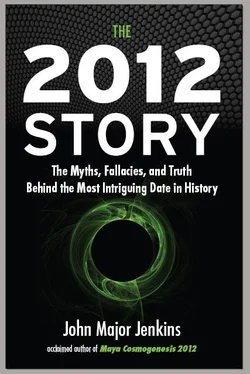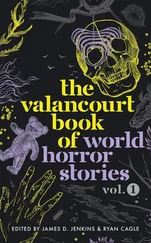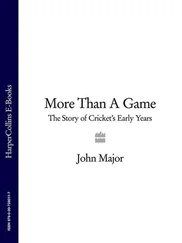Aluna Joy Yaxkin was instrumental in Hunbatz’s well-attended solar initiations of 1995. By 1998 the day-count discrepancy had become a question that Hunbatz wanted to resolve, and he invited me to speak at a Maya Calendar congress he organized in Mérida. Jim Reed led a group that I joined in Champotón, and together we visited Aké, Edzna, and other sites before joining Hunbatz in Mérida. Our groups planned to journey together, after the conference, to Dzibilchaltún and Chichén Itzá. On the conference day in Mérida, Jim encouraged me to emphasize the correct day-count and make no mistake about it. But there were a few other speakers, and I was on last.
The loquacious speaker before me, part of Hunbatz’s group, ended up talking far beyond his allotted time, and I had to quickly adapt my slides for a quick forty-five-minute presentation. This presenter didn’t seem to care or be aware of the duration of his time slot, and he finally had to be interrupted as he had gone on for more than two hours. I then was able to briefly share my reconstruction of the Maya’s awareness of the sun’s alignment with the Pleiades over the Pyramid of Kukulcan. I also emphasized that, historically, the tzolkin was lost in Yucatán but survived in the Guatemalan highlands. March 19, 1998 (the day of the conference), was equal to the day 8 Muluc. (I’ll always remember this because an amazing artist, Furie, gifted me with a glass pendant that day, engraved with the Muluc day-sign.)
The situation of the correct day-count continued, nevertheless, to be unclear among Maya day-keepers, and Hunbatz had been following the Argüelles count. Some writers liked to say that 8 Batz (8 Monkey, the initiation day for day-keepers) was the Maya New Year, which was confusing because New Year’s Day wasn’t technically connected to 8 Batz. Also, the Long Count calendar and 2012 were a lost tradition, and information on it in the literature was unclear. Some terminology and definitions needed to be worked out. Consequently, Hunbatz, as a representative of the Yucatec Maya, invited a contingency of Guatemalan calendar priests to attend the Calendar Congress in Mérida in 1999. The results were mixed, as the Guatemalan day keepers did not seem to get any stage time at the conference. Hunbatz concluded by stating that they were all in agreement, which was clearly not the case. Hunbatz continues to lead a renewed calendar tradition in the Yucatán, driven by solar initiations at the Maya sites.
* * *
In the 1970s Argüelles lived in Boulder, Colorado, and he was involved in the founding of Naropa College in 1974. He was a devoted student of Trungpa Rinpoche, who was known for a spiritual teaching style called Crazy Wisdom. This school of thought, and its leader, became famous for techniques that disrupted the rational mind. The methods were unorthodox and, in retrospect, highly questionable. Some of its “graduates” have claimed that it left them in states of severe confusion. Author Sam Keen had this to say about the proliferation of Wisdom teachers:
One of the things I frankly don’t like about your magazine [ What Is Enlightenment? ] is the holding up of these people who are supposedly “in the absolute” and totally liberated. I don’t know whether you remember, but for many years I was the person at Psychology Today who interviewed all these gurus. And so I’ve had a good bit of experience with a fair number of them—Chögyam Trungpa, Oscar Ichazo, Muktananda and others. And if these are all examples of people who are totally liberated, I say give me slavery because they were people with enormous illusions and who were cultivating enormous illusions in their followers. By and large almost all of them were totally unclear about three important things: sex, money and power. And they could play like they were liberated as long as they had a whole cult of disciples who did everything for them except wipe their asses—and probably that, too. And most of them were on enormous power trips. So I think the idea of total liberation is sort of like the idea of perfection. It’s an idea that is more crippling than helpful. 22
Students of Trungpa Rinpoche in the early days of Naropa had to contend with contradictory statements and behavior offered by their teacher, dealing with jealousy issues by partner swapping, and similar practices characterized as “crazy.” Unfortunately, the progenitor of Crazy Wisdom teachings in the West succumbed, at the age of forty-seven, to alcoholism and heart failure after moving from Boulder to Nova Scotia. Those are the facts of the matter, and I’m not intending to pass judgment on what may have been important spiritual teachings for Westerners of the boomer generation to experience.
Argüelles, in his biography, discussed the extreme yet often endearing nature of Trungpa’s character, and remembers that he benefited from learning presence of mind by practicing dharma art projects, with Trungpa’s guidance, in the late 1970s. 23In my opinion, a devaluing of facts and rational assessment might have been instilled in Argüelles at this time, and Argüelles’s own predilection for creative process and model-making took precedence. The irrational teaching methods of the Crazy Wisdom school may in some way underlie the unorthodox presentation of Dreamspell, which is, as I discussed, irrational and internally inconsistent. In this light I offer my own conclusion that Dreamspell is best understood as a test for seekers who need to strengthen the muscle of discernment and “discriminating wisdom.” It’s a Way Station on the spiritual path, designed to snare seekers who need to develop discernment and rational discrimination before moving on to transrational processing. Here we encounter the idea of a progression of spiritual and cognitive development, from prerational to rational to transrational, which is an important framework for understanding the larger implications of 2012.
INTREPID INVESTIGATORS: HANCOCK, COTTERELL, AND GILBERT
In 1995, while I was finding evidence to support my thesis on the 2012 galactic alignment, two popular books on the Maya calendar appeared in the marketplace. One might suspect that this was triggered by breakthroughs occurring in academia with Linda Schele’s book Maya Cosmos (1993, coauthored with David Freidel and Joy Parker), but neither book mentioned Schele’s work.
Fingerprints of the Gods, by Graham Hancock, dealt tangentially with the Maya calendar while taking a global approach to reviving the old Atlantis hypothesis. To be sure, Hancock had new findings and theories to report, and that he paid special attention to the precession of the equinoxes is important. The Mayan Prophecies , on the other hand, was written largely by a hired coauthor who had very little research into the Maya traditions under his belt. We should treat both books separately, as they are very different.
Graham Hancock had achieved some fame with his well-researched book on the Ark of the Covenant The Sign and the Seal (1992). He pretty much defined the genre of globe-trotting sleuth scholarship. His provocatively titled book Fingerprints of the Gods explored the premise that an unrecognized earlier civilization had existed before the widely accepted date for the advent of civilization—around 4000 BC. It’s the old Atlantis idea that preoccupied Charnay and Le Plongeon, but today we can draw on the work of, for example, Marija Gimbutas, which shows conclusively that prior to the advent of patriarchal monotheism a cultural phenomenon bearing all the marks of civilization existed in Neolithic Europe. This Magdalenian phase began roughly 17,000 years ago. Likewise, compelling structures that seem to be megalithic sites recently found off the coasts of Japan and India imply high culture around 15,000 BC. Hancock rallied his own insights while summarizing the progressive research of others to present a compelling case that something wasn’t being acknowledged by conventional historians and other status quo gatekeepers.
Читать дальше












